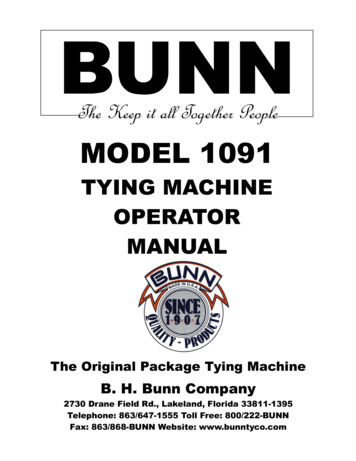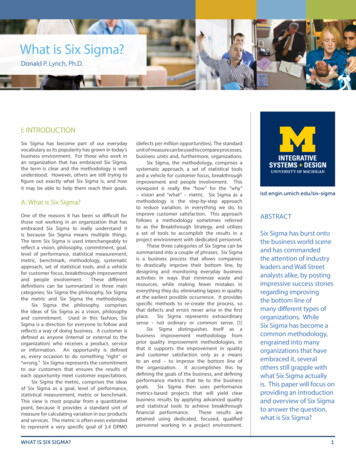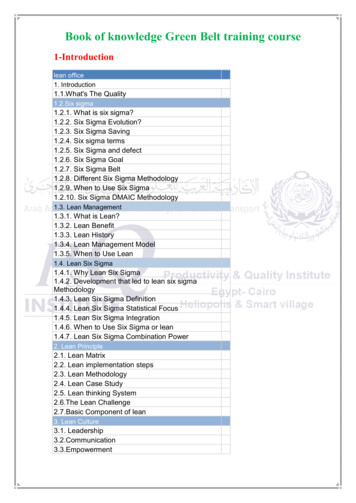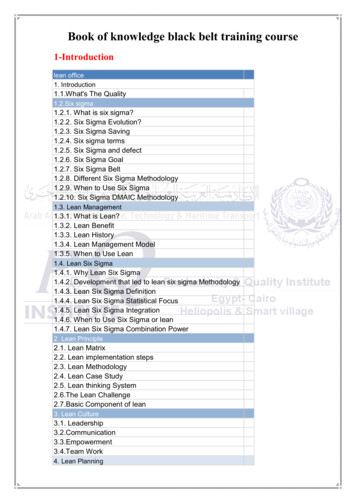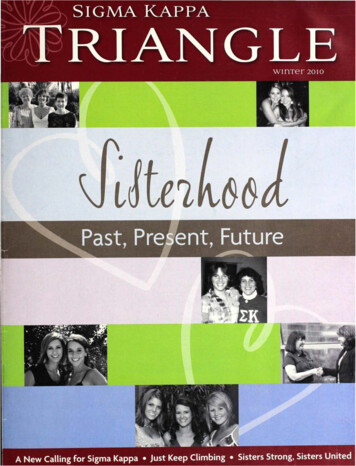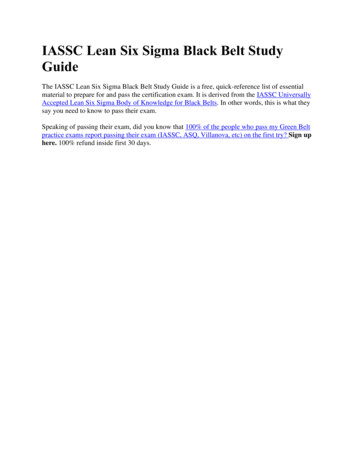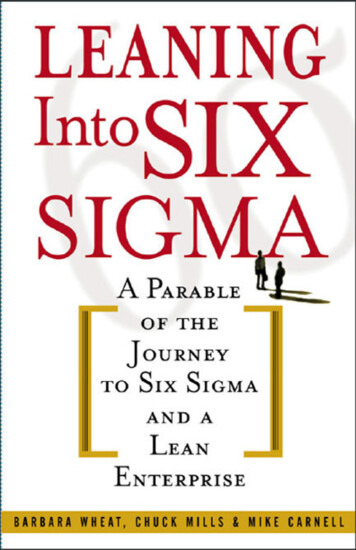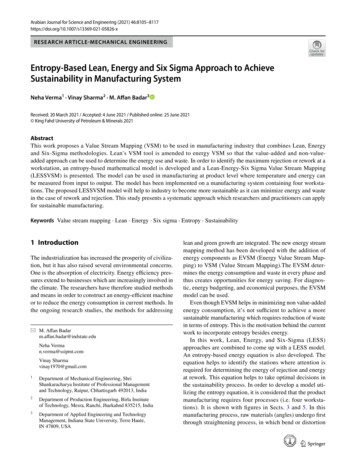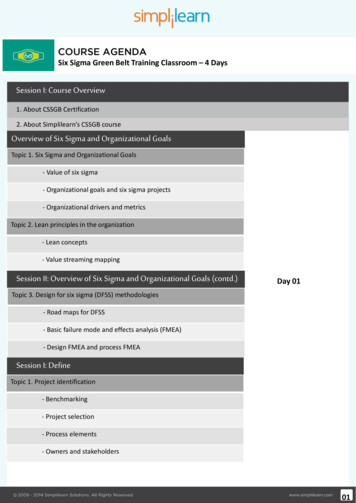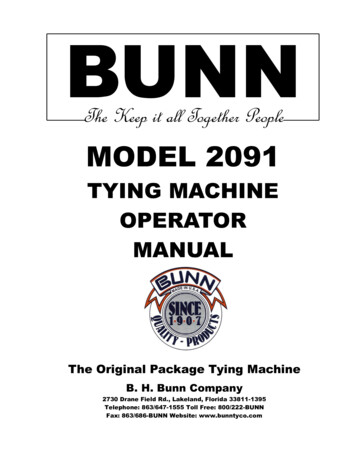
Transcription
BUNNThe Keep it all Together PeopleMODEL 2091TYING MACHINEOPERATORMANUALThe Original Package Tying MachineB. H. Bunn Company2730 Drane Field Rd., Lakeland, Florida 33811-1395Telephone: 863/647-1555 Toll Free: 800/222-BUNNFax: 863/686-BUNN Website: www.bunntyco.com
BUNN TYING MACHINE SERIAL #NoticeDo not attempt to operate this Equipmentbefore reading the operation instructions andperforming the Before Operation Checksparagraph in section 3 of this manual.OPERATOR SAFETY REMINDERSThe National Safety Council reminds us that most accidents are caused by the failure of some individual to follow simpleand fundamental safety rules or precautions. For this reason, you as a careful operator, are the best insurance against anaccident. Regardless of the care used in the designand construction of any type of equipment there are many conditions that cannot be completely safeguarded againstwithout interfering with reasonable acces- sibility and efficient operation.NEVER ATTEMPT TO THREAD,CLEAN, OIL OR ADJUST A MACHINEWHILE MOTOR IS OPERATING ORMACHINE IS IN MOTION.NEVER OPERATE MACHINE WITHANY GUARD OR PANEL REMOVEDAND KEEP HANDS AWAY FROM INSIDE OF GUARD TO AVOID BEINGSTRUCK BY THE TWINE ARM.DO NOT REMOVE GROUNDINGPRONG FROM THE POWER CORD.2091 MANUAL PART NO. 139076
Tying MachineOperator ManualForewordThis manual contains instructions for installation, operation, preventative maintenance, troubleshootingand repair parts identification for your tying machinemanufactured by the B. H. Bunn Company, Lakeland,Florida. Proper use of the manual should ensure safeand efficient operation and maintenance of the tyingmachine. Because of the increasing staff of ServiceRepresentatives, B. H. Bunn Company can nowoffer a Maintenance Contract. Contact your local service representative, who is capable to render factoryapproved service, for full details maintenance contract information or the B. H. Bunn Company.This manual may not be reprinted or reproduced,either in whole or in part without written permissionof the B. H. Bunn Company.ContentsSection I –IntroductionPage Section IV – MaintenancePurpose of Tying Machine . . .2General Description . .2Principles of Operation . . . .2,3Basic Types of Different Wraps. . . .4PageLubrication Requirements . . .8Maintenance . . 9Introduction . . . .9Table of Lubrication Requirements . . .9Section V – TroubleshootingThe Perfect Knot . . 10Uncrating Instructions. . . .5Section II – Preparation for UsePower Requirements . . .5Tying Materials . . .5Threading Procedures . .6Section III – OperationBefore Operation Checks . . .7Tying Size Limitations. . .7One-Way Operation . . .7Cross-Wrap Operation . . .7After Operation Procedures . .71/12Table of Troubleshooting Information .11,12Section VI – Parts ListParts List Information .13Main Table Assembly . .14Knotter Head Assembly . .15Stringholder and Knife Trap Assembly .16Main Cam Assembly . .17Main Table Support & Kick OutAssembly . .18Main Shaft, Main Gear & ChainGear Assemblies . .19Main Clutch Assembly . . .20Twine Arm Assembly . . .21Supplement Pages (1091-AC only)1
Section I - IntroductionPurpose of Tying MachineThe primary purpose of the tying machine is to automatically tie mail, packages, cartons, piece parts, printed matter, newspaper, laundry, produce, meats, corrugated cardboard and miscellaneous materials and products requiring a secure wrap (figure 1). The tying machine ties almost everything that was previously wired,banded, taped, strapped, tied by hand in offices, factories and commercial establishments. The tying machine reduces tying time, employee effort and fatigue, reduces twine lint and waste, enables trained operators to make secure ties quickly, ties larger bundles with greater ease and efficiency and discourages tampering because the knot cannot be duplicated by hand tying.General DescriptionThe tying machine is made of steel, cast iron and high impact plastic construction. Heavy duty panels andguards completely enclose the moving parts of the tying machine to prevent accidental operator contact.However, the unique design of the tying machine still provides the operator with easy accessibility tomaintenance points without the use of tools. For ease of mobility, caster wheels are used. A brake featureon each caster resists the movement of the tying machine when assigned a permanent position. The “ONOFF” switch (used to supply electrical power) and a foot pedal (used to initiate the tying cycle) are withineasy and comfortable reach of the operator. The material tying area consists of a front table, back table, andstandard. A knotter head assembly, stringholder assembly, twine arm and drive assemblies comprise thetying cycle components.Principles of OperationDouble Wrap One WayWith the tying machine power cord connected to an approved power source and the material to be tiedproperly positioned on the front table and the back table, the operator then places the “ON-OFF” switch inthe “ON” position. Electrical ac power is then transferred by the switch to start the motor. The motor rotating at approximately 1725 rpm drives the pulley on the clutch via a V belt mechanically coupling the pulleyassembly to the motor. At this time, the tying machine is considered to be in a locked condition until theoperator applies toe pressure to the foot pedal to begin the wrapping and tying cycle. Depressing the footpedal causes the trip cable to position the bell crank and kickout assembly so the kickout wedge slides freefrom the clutch fork assembly. Repositioning the kickout wedge permits the lever clutch of the kickoutmechanism to first pull away from the clutch kickout block on the main cam assembly and then is engagedby the clutch fork. As soon as this occurs, the clutch shaft becomes unlocked and starts to rotate which inturn drives a series of gears; main shaft, main gear and chain gear. As a result, the twine arm begins toswing around the package being tied pulling the twine from the twine cone pilot assembly, through theproperly adjusted tension device and each threading guide. After the second swing of the twine arm, thedrawslide is positioned to allow the twine to fall directly behind the stringholder button. The drawslide thenpushes the twine from the stringholder button to the left side of the forward moving knotter body as viewedfrom the right hand side of the tying machine.21/12
Section I – IntroductionContinuedSimultaneously, the twine arm is continuing its arc and the knotter body turns counter clockwise openingthe jaw for the two strands of twine which are wrapped around the knotter body assembly. The strands oftwine are brought through the jaws and the jaws firmly lock. The knotter body assembly then moves towards its finished position and the stripper forces the twine strands off the knotter body jaws, into the tightpart of the knot. As the two strands of twine are pulled into loops from the knotter body assembly jaws, theknifetrap moves forward and cuts a fresh end of twine and pushes the previously cut end of twine from behind the stringholder button. The knotter body assembly completes its movement to finished position andthe knotter body assembly jaws open to release the loops completing the tying process.The tied bundle is then removed from the tying machine.Double Wrap Cross TieThe double wrap cross-tie tying cycle (available on all models except 1991) operates in exactly the samemanner as the double wrap one way tying cycle previously described above except that the twine arm rotates once around the bundle being tied then automatically stops. The operator properly repositions the bundle 90 degrees in a clockwise direction, again applies toe pressure to the foot pedal and the twine arm rotates around the bundle once more automatically completing the knot tying process. The bundle is crossedtied in each direction with one strand of twine and is tied with one knot.1/123
Basic Types of Different WrapsSingle Wrap —The arm carries the twine armaround once and the knot isformed.Double Wrap — One WayTwo wraps in one directionwith one knot.Triple Wrap — One WayThree wraps in one directionwith one knot.Double Wrap* — Cross TieOne wrap in each direction withonly one knot.Triple Wrap** — Cross TieOne wrap in one direction; Twowraps in other direction — withonly one knot.** Triple wrap cross tie additionally provides: (1) Threewraps in one direction if package is not turned betweenwrap cycles; (2) two wraps one way by tripping out thefirst wrap.4* Double wrap cross tie also provides: (1) two wraps inone direction if package is not turned between wrapcycles; (2) one way by tripping out the first wrap.1/12
Section II - Preparation For UseUncrating instructions1. Cut bands securing the carton to the skid.2. Cut the bottom of the cardboard carton where it is secured to skid.3. Carefully raise and remove the carton from the tying machine.4. Carefully remove the steel strapping from the machine and then pull the tying machine awaytheskid.from5. Remove the box in the twine container shipped with the tying machine containing four casters.7. Using the casters shipped with the tying machine, insert a caster into the caster socket on each leg of thetying machine.Note:panyThe manual should be wrapped around the knotter at standard, along with the warranty card,certificate and spare knives. If any problems are encountered, contact your local B. H. Bunn ComDistributor.Power requirementsThe single-phase, 1/4 hp, 1725 rpm standard motor provided with your tying machine requires an externalpower source of 115 volts at 60 cycles. A standard three-prong electrical cord is provided with electric motor. If a three-prong receptacle is not available at the installation site, a three-prong adapter should be usedwith the electrical cord.Tying MaterialsThe tying machine is adaptable to a wide range of tying materials ranging from natural fiber twines to synthetics which can replace wire and strapping in many applications. Be sure the twine or tape used is theproper type and size for the application and your Bunn machine. Each new or factory reconditioned BunnTying Machine is factory adjusted and set for a particular size and type of twine. Other sizes or types willrequire adjustments and may require internal part changes. The right Bunn Twine, tested and approved forBunn Tying Machines, aids in maximum machine performance. Bunn Twine is of uniform size andstrength, free of irregularities that cause mis-ties. It is strong and fray-resistant, with minimum linting characteristics.A free sample folder showing actual twine samples and specifications is available through yourlocal B. H. Bunn Company Distributor.Conversion kits are available through your local B. H. Bunn Company Distributor when and if it ever becomes necessary to change to a different material – twine to tape or tape to twine. The twine container willhold up to a 5-pound cone of twine. The base diameter of the cone must not exceed 9 inches.1/125
Threading ProceduresBefore the tying machine is shipped, it isthreaded through each guide starting from the twinecontainer to the stringholder button. To avoid threading problems in the future, you should become familiar with the threading sequence at this time.Complete threading of the tying machine canbe avoided if the end of the twine or tape being usedis caught before it leaves the twine container. This isaccomplished by simply tying the end of the existingtwine or tape to the starting end of the new twine or tapewith a square knot.If the end of the twine or tape is not caught before itleaves twine container, the tying machine must be threadedas explained in the subsequent procedures.It is important to observe the various openings whichare identified by numbered labels affixed to the machinewhich the twine or tape is to be threaded.Never thread machine while motor is operating.Place twine cone over cone pilot assembly.Press firmly until cone is seated on foam pad atbottom of twine container. Note: Cone pilot assembly is adjustable if cone does not seatproperly. Grasping end of twine, thread throughguide21Fish twine out from quill shaft on inside of machine. Thread twine throughtension device # 3 under tension spring between pins. Spring may be liftedGENTLY to facilitate this procedure. Continue to thread through roller # 4, endof drawback lever #5, rollers # 6, #7 and through the tip of the twine arm # 8.436785Pull twine to right side of machine. While gentlypulling the stringholder release lever, place the twineunder stringholder button # 9. Pull twine up and overbutton shaft and release stringholder release lever.Pull the twine taunt to cut off excess twine.961/12
Section III – OperationBefore Operation Checks5. Remove package from tying machine.1. Turn “ON-OFF” switch to the “OFF” Position.6. Repeat steps 3 through 5 above for each package to be tied.2. Check for proper threading.7. After all packages have been tied, set the “ON-OFF” switchto “OFF” position.3. Check if twine or tape cone is properly seated on foampad of twine container.Cross Wrap operation4. Check twine running tension by pulling twine from endoftwine arm assembly. A smooth easy running tensionshould be felt.5. Visually check the tying machine for any mechanicaldefects or missing parts.Tying Size LimitationsThe capacity graph on the Model CharacteristicsSheet at the front of the manual indicates the maximumheight and width of the packages that can be tied. Bunn tying machines adjust automatically to handle most packagesof varying sizes and shapes that are smaller than it’s maximum capacity.Throat depth is the distance from the back of theback table to the twine line, or the maximum distance youcan slide the package into the tying machine. The “throat”depth is also tabulated on the Model Characteristics Sheet.1. Stand in front of the machine at the operating position—the widest side of the fixed table.2. Set “ON-OFF” switch to “ON” position.3. Hold ends of package between thumbs and forefingers ofboth hands and position package on tying machine tablesothat right side of package is butted against the standardornotch in front table and positioned over gap betweenfrontand back tables.4. Depress foot pedal holding package firmly until tying armcompletes one revolution.5. Turn package 90 degrees IN CLOCKWISEDIRECTION in tying machine.6. Depress foot pedal (second time) holding package firmlyuntil tying cycle is completed.One Wrap Operation7. Remove package from tying machine.1. Stand in front of the tying machine at the operatingposition— the widest side of the fixed table.8. Repeat steps 3 through 6 above for each package to be tied.2. Set the power switch to “ON” position.3. Hold ends of the package between thumbs and forefingersof both hands and position package on tying machinetable so that the right side of the package is buttedagainst the standard and positioned over the gapbetweenthe front and back tables.4. Depress foot pedal holding package firmly until tyingcycle is completed. The tying cycle is completedafter thetwine arm makes the required wraps, one, two, orthree.NOTEThe tying machine automatically compensates forthe size and shapes and the different lengths of twine re1/129. After all packages have been tied, set “ON-OFF” switchto “OFF” position.After Operation Procedures1. Check supply of twine or tape remaining in twinecontainer. If supply is low tie the end of the existingtwineor tape to the starting end of the new twine or tape withasquare knot.2. Clean any lint that may have collected in stringholdercasting between the face and stringholder casting. Smalltweezers can be used for this purpose.3. Clean the machine by using an air compressor to blow theexcess dust from the machine.4. Check the knife blade for any knick or dull blade.Replace if necessary.7
Section IV – MaintenanceLubrication RequirementsARROWS IN PHOTOS IDENTIFY OIL HOLES AND LUBRICATION POINTSPlease refer to Lubrication / Maintenance for frequency.Knotter HeadFrontRearMainshaft,ClutchshaftMain Table, ClutchFork, Kickout Wedge.Knotter Head SideView, Dual Tension,Knife TrapFront FrameMain Shaft,DrawslideLeverMain Table81/12
IntroductionSection IV – MaintenanceA good preventative maintenance program is a major stepforward to assure trouble-free tying machine operation. In order tobe effective, routine inspection, lubrication and adjustment schedule must be established and followed.For tying machines subjected to normal usage which isconsidered to be approximately 30 hours of operation weekly, thefollowing maintenance and lubrication schedule should be followed. Substantial deviations from normal usage should require anadjustment in the indicated frequencies.The Lubrication Requirement has frequencies of 50 and 150hours. The following mechanical components should be checkeddaily: Stringholder button holes for lint or twine buildup, knife condition, V-belt tension, loose hardware and broken or weak knotterflat springs. The twine running tension should be checked on amonthly basis.Any abnormal noises or loose components should be inspected and corrected. Power cord should be checked for fraying andthe motor inspected for excessive lint or dirt.LUBRICATION ITEMNote: Apply several drops of SAE oil or equivalent unless otherwise specified. If necessary, refer tothe exploded view in the parts list section of this manual for assembly part nomenclature.Frequency30 Hours90 HoursKnotter Head Assembly1. Oil cup (Knotter Head Pivot).X2. Two oil holes (encircled in red on machine).X3. Between knotter lever and knotter head assembly.X4. Around diameter of knotter roller.X5. Knotter lock plunger.XStringholder Assembly1. Between knife trap pivot and knife trap lever assembly.X2. Between knife trap shoulder screw and knife trap lever assembly.XMain Table Assembly1. Around diameter of drawslide lever assembly roller.X2. Between washer and drawslide lever.X3. Between drawslide lever assembly and main table subassembly.X4. Into three oil holes (encircled in red on machine).X5. Between stripper and main table subassembly so that stripper pivot pin is lubricated.XNOTE: Apply a liberal coat of recommended lubricant to the following unless otherwise specified.Drive Assembly1. Main gear cam surface.X2. Knotter rack assembly cam surface and teeth.X3. Cam riser surface.X4. Knotter switch cam surface.X5. Apply several drops SAE 10 oil to chain gear oil hole (encircled in red on machine).X6. Apply several drops of SAE 10 oil to the two oil cups.X7. Apply several drops of SAE 10 oil to the back frame two oil holes (encircled in red on machine).X8. Main shaft (encircled in red on machine).X9. Clutch shaft (encircled in red on machine).X10. Clutch fork pivot (encircled in red on machine).X1/129
The Quality KnotTells the StoryTHIS IS APERFECT KNOTA perfect knot, like the illustration,has two long even loops extendingout one side of the knot with oneshort and one long end, the body ofthe knot is tight and hard. The stripper should be on the line where theupper and lower jaws meet at the lipof the lower jaw and very little spacebetween them as the stripper comesdown to push the twine off of theknotter.Important!YourBUNN PACKAGE TYING MACHINEwill tie perfect knots every time whenin proper adjustment.B. H. Bunn Company2730 Drane Field RoadLakeland, Fl 33811-1395Phone 863/647-1555 Fax 863/686-BUNNToll Free 1-800-222-BUNN Website www.bunntyco.com101/12
Section V Trouble ShootingThis section of the manual contains a Table of Trouble Shooting information for locating and correcting mostof the troubles which develop in the tying machine.The tying machine is generally trouble free. However,the tying machine suffers the usual wear and misadjustment from normal use. Careful inspection and accurate analysis of the symptoms listed in theTable of Trouble Shooting Information will localizethe trouble more quickly than any other method.This manual cannot cover all possible troubles anddeficiencies that may occur, therefore if a specifictrouble is not covered herein, proceed to isolate themajor component in which the trouble occurs and thenisolate and correct the problem.TABLE OF TROUBLE SHOOTING INFORMATIONTROUBLEa.Tying machine will notoperate with “ON-OFF” switchset to “ON” position.1/12POSSIBLE CAUSECORRECTIVE ACTIONElectric power cord not plugged intoreceptacle.Plug electric power cord intoreceptacle.Circuit breaker tripped.Reset circuit breaker. If circuit breaker trips again, inspect and test forshort in tying machine circuit or electric power cord. Correct defect as required.Broken or disconnected circuit wire.Repair or replace broken wire.Faulty “ON-OFF” switch.Replace defective “ON-OFF” switch.b. Twine (or tape) breaksfrequently in stringholderbutton.Improper twine (or tape).Use proper size of twine (or tape).Excessive stringholder button tension.Readjust stringholder button pressure.c. Half or single loop on knot.Piece of twine (or tape) wrapped aroundstringholder button shaft relievingtension on twine (or tape).Depress and hold button release leverand remove bits of twine (or tape)using a small pair of tweezers.Then release the button release lever.d. One loop knot that slippedout.Excessive twine running tension.Readjust to decrease twine runningtension.e. One long and one shortloop.Improper twine (or tape).Use proper size of twine (or tape).One loop catching in back ofknotter throat, improperknotter release adjustment.Readjust knotter release.11
Trouble Shooting Information (cont.)TROUBLE12POSSIBLE CAUSECORRECTIVE ACTIONf. Break in twine front of knot.Friction along twine (or tape) path.Remove edges from twinepath in twine tension plateassembly, twine bracket, quillshaft, twine arm hub, twinearm elbow assembly, drawbacklever and twine arm tip.g. Ragged ends of twine at knot.Dull or knicked knife blade.If knife is excessively knicked,replace. If knives continuebeing knicked, lubricate knifetrap pivot points to assure thatknife trap does not stick,allowing knife to remain inpath of drawslide.h. Loose knots and loops slightlyshorter than normal.Loops release from knotter too soon,improper knotter release adjustment.Readjust knotter release.Stripper too short.Replace stripper.i. Short loops and tight knot.Improper balance betweentwine running tension andstringholder button pressure.Check stringholder buttonpressure. Readjust twinerunning tension.j. Cut loop ends.Stripper points shearing against side ofknotter jaws when stripping.Readjust stripper shear action, bend topfront end of stripper down by tappingwith a light hammer.k. Very short loops and ends.Knot slipping by stripper. Improper gapbetween stripper point and knotter.Realign stripper point and knotter.Knotter flat springs broken or weak.Replace knotter flat springs.l. Twine (or tape ) catches instripperStripper spring broken or weak.Replace stripper spring.m. Twine (or tape) pulls out ofstringholder button.Twine ( or tape) improperly threaded.Check stringholder button threading andrethread if necessary.1/12
Section VI – Parts ListThe tying machine is identified by the Model Characteristic Sheet and serial number stamped on the name plate located on the front frame of the machine.Be sure to use both the model number and the serial number when requesting partinformation or when ordering replacement parts.Using the complete equipment identifier (model number and the serial number)will ensure receipt of proper replacement part or parts.If your tying machine is equipped with a frame extension or special modifications,please provide the information along with the complete model identifier when ordering replacement parts.1/1213
MAIN TABLE ASSEMBLYUSE SERIALNUMBER WHEN ORDERINGALL REPLACEMENTSPARTS.IndexPartNumber Number DescriptionQtyReqIndexPartNumber Number 08009045034Main Table AssemblyStud, Riser LeverStud, Drawslide LeverPin, Drawslide SpringMain Table Sub AssemblyDrawslide 3100597032035Nut, Jam Hex 1/4-28 NFStud, Knotter ReleaseStud, Knotter Head StopGuide, Riser PinScrew, Pan Head, Self Tap 10-24 NC X 5/8 inTip Up 8Spring, DrawslideRiser LeverScrew, Set Square Head Dog Point 1/4-20Nut, Hex 1/4-20Screw, Round Head 10-24 NC x 3/8 9StripperPin, Stripper PivotSpring, StripperPin, RiserDrawslide Cap 104100135100115Washer, Drawslide LeverScrew, Drawslide LeverBracket, Drawslide SpringScrew, Drawslide Cap, 1/4-20 x 1 Fillister HeadWasher, Split lock 1/4Screw, Hex Head 5/16-18 x 111122218100018Washer, Flat 1/2 OD x 7/32 ID x 3/64 in ThickLever, DrawslideWasher, Drawslide LeverScrew, Flat Head Slotted 1/4-20 NC x 1/2 inScrew, Set Square Head Cup Point 1/4-20 x 3/4Screw, Set Socket Head Cup Point 8-32 x 1/4inScrew, Knotter Release Adjusting136100615Screw, Hex Head 5/16-18 x 1-1/41* Not Part of Assembly, Order Separately.** Sub-Assembly includes Items 2, 3, 10, 17, 18, 19, 20, 21, 22, 23, 30 and 31.*** Specify Type of Twine or Poly Tape Being Used.(For 6-8-10 ply twine or 24/28 Poly tape use 052021, 12-16 Ply twine or 35 Poly tape use 052022)141/12
KNOTTER HEAD ASSEMBLYUse serial number when orderingall replacement parts.IndexPartNumber Number DescriptionQtyReqIndexPartNumber Number DescriptionQtyReq1017***Knotter Head Assembly113032042Lever, Knotter12017035Knotter Head Sub– Assembly (Note 1)114100009Screw, Shoulder Knotter Lever13081020Knotter Head roller Stud115100143Nut-Hex, 10-2414064008Knotter Head Roller116100370Screw, Set Socket Head Cup Point 10-24 x 3/1615020157Star Wheel & Miter Gear Assembly (Note 2)117100701Oil Cup16082003Plunger, Knotter Lock118017***Knotter Body & Miter Gear (Note 2)17074006Spring, Knotter Lock119011004Pivot, Knotter Head18100187Screw, Set Knotter Lock 1/4-20 x 1 1/2 HalfDog120100521Nut, 5/16-18 Nylon Insert19100150Nut, Hex Knotter Lock121100174Pin, Roll110074013Spring, Knotter Flat222100280Washer, Flat111100131Washer, Flat123100119Screw-Hex 5/16 x 1/2112100092Screw, Round Head 10-24 x 1 in Long124081022Stud, Tip up Lever1*** Specify Type of Twine or Poly Tape Being UsedNote 1: Sub-Assembly includes Items 3,4,20,21 and 24 Note 2: Includes Items 5A and 5B (ONE OF EACH).1/1215
STRINGHOLDER ANDKNIFE TRAP ASSEMBLYUse serial number whenordering all replacementparts.IndexPartNumber NumberDescriptionQty IndexReq der Assembly113030084Lever, Slide12030***Stringholder and Pins Sub Assembly114100565Screw, Socket Head Cap13030147Button, Stringholder115100011Screw, Knife Trap Shoulder14100489Screw, 10-32216030083Pivot, Dual Tension15074***Spring, Stringholder button117100088Screw, Pivot26100144Nut, Hex 10-32418030085Angle, Dual Tension17032218Lever, Button Release119030086Link, Dual Tension18100646Screw, Knife Trap Pivot120100146Nut, hex 12-24 X 20 ESNA29032159Knife Trap & Lever Assembly121100187Screw, Set Half Dog Point 1/4-20 X 1110100090Screw, Binder Head 8-32 x 1/4122100188Nut, Hex 1/4 X 20111021009Knives, Package of 10123100158Pin, Groove112074011Spring, Knife Trap124100569Pin, Groove225030***Face, Stringholder1* Assembly does not include items 14, 15, 18, 19, 20, 21 and 22, Order Separately*** Specify Type of Twine or Tape Being Used161/12
MAIN CAM ASSEMBLY*Use serial number whenordering all replacementparts.IndexNum-PartNumberDescriptionQty IndexPartReq Number NumberQtyReq1* 009033Main Cam Assembly110100127Screw, Set Square Head Knurled Cup Point5/16-18 x 1 1/2 in12009059Main Cam Sub Assembly111100095Screw, Machine Flat Head 10-24 x 5/8 in23009025Switch, Cam Knotter Head (includes pin)112209007Riser, Cam14100109Screw, Socket Head Cap 1/4-20213009026Clutch, Kickout Block (two required for crosstie)15020135Rack, Knotter Cam114100161Pin, Knotter Cam Groove16009078Ring Cam (Sold as set only)115100160Pin, Drawslide Ring Cam Groove17100328Screw, Machine Flat Head 12-24 x 5/8 in216100372Pin, Knotter Rack Roll28100326Screw, Machine Flat Head 10-24 x 7/8 in417100712Screw, Socket Set Cone Point29100128Screw, Set Square Head Knurled Cup Point5/16-18 x 1 1/4 in118100102Screw, Machine Flat Head 12-24 x 3/42Description* Includes all Items #2 through #181/1217
MAIN TABLE SUPPORTANDKICKOUT ASSEMBLYUse serial number when orderingall replacement parts.IndexPartNumber NumberQtyReqDescriptionIndexPartNumber NumberQtyReqDescription1084014Main Table Support and Kickout Assembly112100286Nut, flanged Hex Head 1/4–2032032018Lever, Clutch Kickout113100503Pin, Groove 3/16 x 1 1/213100005Screw, Trip114*100273Screw, Hex Head 5/16-18 X 5/8 “Whiz Loc”24100151Nut, Hex Head 1/4 – 28115011034Trip Extension15100135Washer, Split Lock116*074050Spring, Trip Cable16074054Spring, Trip Return117100238Screw, Hex Head 1/4-20 X 1 1/427011007Bell Crank and Kickout Wedge Assembly118*100690S-Hook18100158Pin, Groove 3/16 X 1119100770Trip Screw, New Style19*011022Cable, Clutch Trip120100138Washer Lock110084048Main Table Support Sub Assembly121100442Nut111100450Screw, Hex Head 1/4–20 X 11* Not part of assembly. Order separatelyNote 1: Includes item 13. Note 2: Includes items 12, 13 & 17181/12
MAIN GEARANDCHAIN GEAR ASSEMBLYUse serial number when ordering all replacement parts.IndexPartNumber Number DescriptionQtyReq.IndexPartNumber Number DescriptionQtyReq.1012183 Main Shaft16020*** Chain Gear Assembly12083057 Key, Main Cam17081072 Stud, Chain Gear Assembly13083074 Key, Main Gear18100087 Oil Cup 90º14020*** Main Gear19100128 Screw, Set Square Head Knurled Cup Point5/16-18 x 1/1415100127 Screw, Set Square Head Knurled Cup Point5/16 –18 x 1 1/21NOTE: When Changing either the Main Gear o
BUNN The Keep it all Together People The Original Package Tying Machine B. H. Bunn Company 2730 Drane Field Rd., Lakeland, Florida 33811-1395 Telephone: 863/647-1555 Toll Free: 800/222-BUNN Fax: 863/686-BUNN Website: www.bunntyco.com MODEL 2091 TYING MACHINE OPERATOR MANUAL
